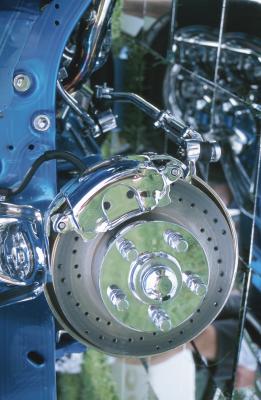
Brake systems, like everything else on your car, have a certain temperature range in which they're completely functional and happy. While manufacturers do their level best to make this range as wide as possible, even the savviest would have trouble building a brake system that worked as well at negative-10 degrees as it does at 110 degrees. Of course, making sure that the brake system works in the first place will help you take advantage of what range you do have.
Consider this: A 3,000-pound car is traveling at 55 miles per hour; it used about 6.5 ounces of gas to accelerate to that speed. Gasoline contains about 114,000 British Thermal Units of energy, so the energy that went into accelerating the car comes out to about 5,700 BTU. When you hit the brakes, all of that energy has to go somewhere, and that somewhere is into your brakes. Brakes convert kinetic energy -- movement -- to frictional heat by squeezing a set of pads against a brake rotor. Until the pads squeeze the rotor hard enough and long enough to produce heat, you've got what amounts to zero in the way of braking power.
All brake pads have an upper and lower temperature threshold, or range in which they'll work. Performance enthusiasts tend to place more emphasis on the upper temperature range, where the mass of the car can impart enough thermal energy to the brake pads to cook them into a slippery jelly and induce brake fade. But brakes have a lower temperature range, too. When cold, the molecules in the pad contract and make it as hard as a rock. This reduces the frictional difference between the pad and rotor, meaning that the two will grip about as well as you'd expect a slab of granite to grip steel.
If you've ever gotten brake fluid on your hands, you may have noticed that, even 20 minutes or so after wiping it away, your hands still feel dry, scaly and in definite need of moisturizer. Brake fluid is hygroscopic, meaning that it will attract and absorb water like a magnet -- it'll even absorb moisture and humidity in the air. The problem is that the water in your brake system won't stay suspended in the fluid forever. Water is denser than brake fluid, and eventually it'll sink to the lowest point in the system. Unfortunately, the lowest point in your brake system is usually the calipers, where the slave cylinders are. Water plus freezing temps equals an ice cube in your slave cylinders, and that will kill your brakes until you get enough hot in them to melt the ice.
If you live in an area that regularly sees 100-degree-plus temperature extremes, you might consider switching to a brake pad with a lower-temperature operating range. The ideal thing would be to use one set of brake pads in the summer and another in the winter, but that isn't really practical unless you're a fleet owner who regularly changes pads anyway. If you want to run a more fade-resistant high-temperature pad, then the simple solution is to lightly ride your brakes for a thousand feet or so when the car's been sitting for a few hours or more. If you've got water in the system, you'll need to bleed the brake system to get rid of it. After bleeding the system to get rid of the water, invest in a new rubber brake fluid reservoir seal to keep additional moisture out of the system.